Looking for the best toothbrushes for dogs? Here are 6 we highly recommend for fresh breath and a healthy mouth
Keep your pup's teeth in tip-top condition using the best toothbrush for dogs.
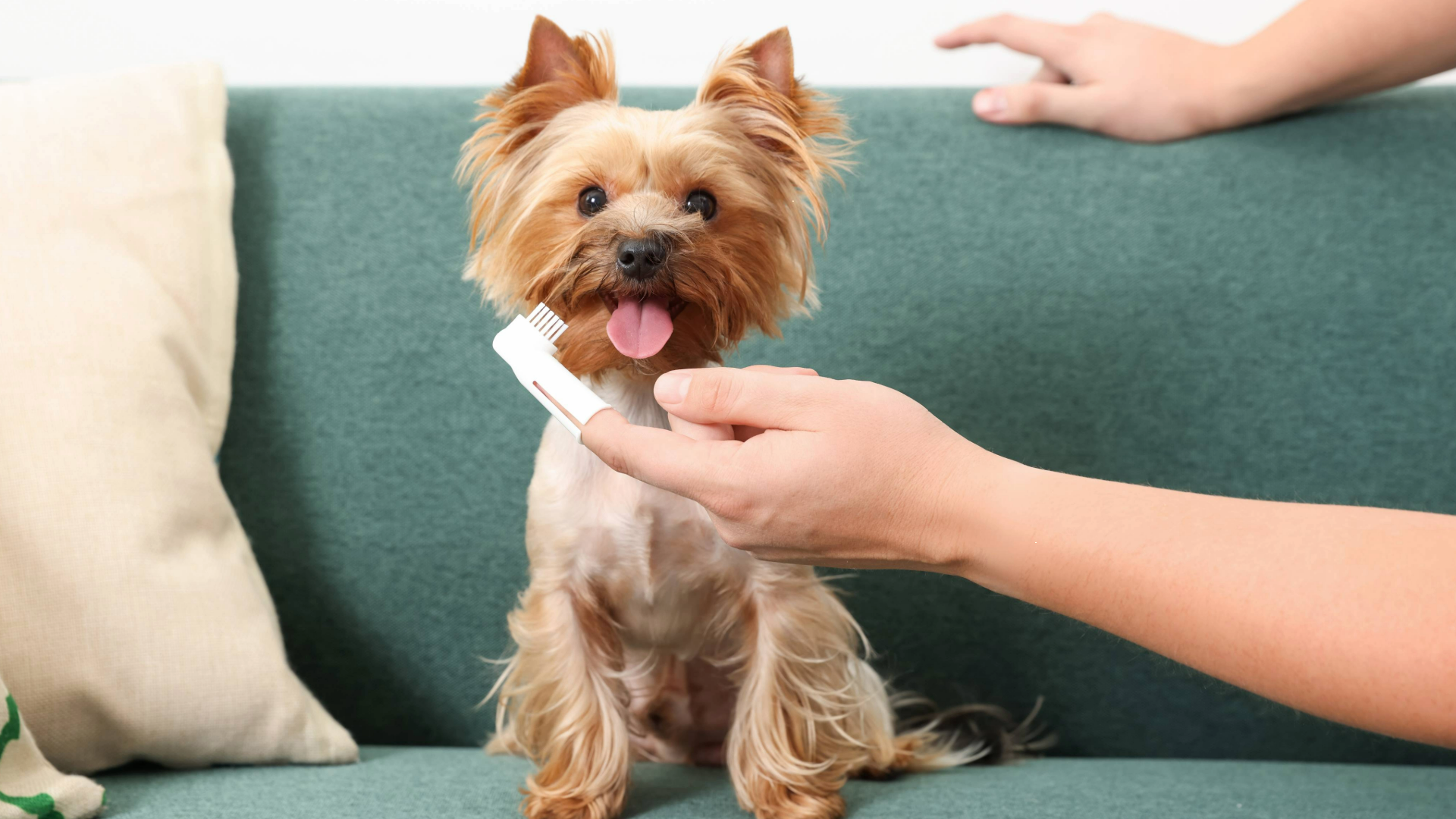
If you're a pup parent, it's important to clean your dog's teeth regularly using one of the best toothbrushes for dogs. This might come as a surprise, but poor dental hygiene can lead to an array of health issues including gum disease, tooth loss, and infections that can spread around the body.
There are plenty of options on the market, from manual brushes to electric versions, and we've rounded up the best of the best below. If your dog hates having their teeth cleaned, you might find a silicone finger brush easier to use, as it gives you more control over their mouth. However, vet Dr. Rebecca MacMillan advises that traditional brushes with soft bristles are typically more effective.
After consulting our in-house vet team and conducting extensive research for hours, we've shortlisted the six best toothbrushes for dogs. We've also asked Dr. MacMillan to share her expert advice on when to start brushing your dog's teeth and how often to replace their brush.
If you want to learn how to brush a dog's teeth, this helpful feature will guide you through the process. We've also rounded up the best dog toothpastes, which are approved by vets and pup parents, in this buying guide.
The best toothbrush for dogs 2025
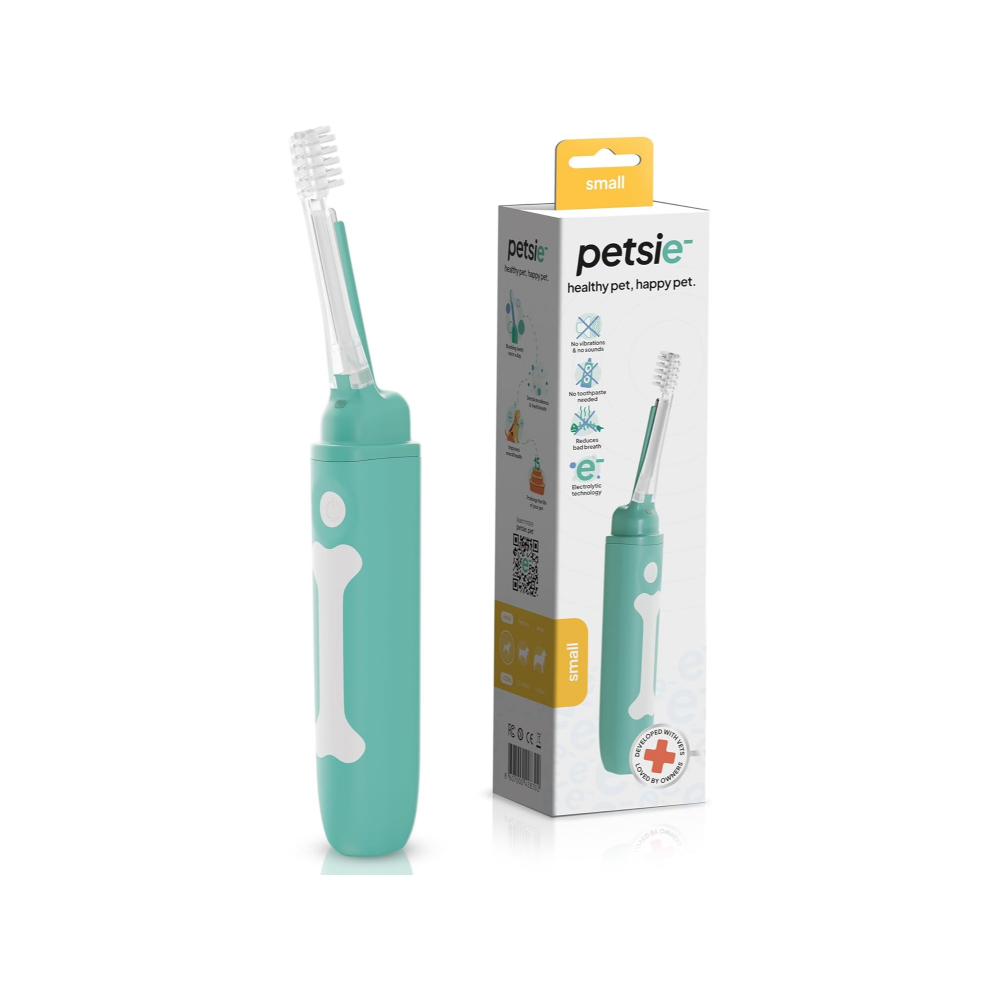
The best electric toothbrush for dogs
You might expect your dog to hate the sensation of an electric toothbrush—but hear us out! This one is completely silent and free of vibrations, making it an excellent choice for nervous pups. Designed to last for years, the toothbrush features a replaceable head that clips on and off and is available in multiple sizes.
You can connect the brush to an app to track your dog's dental habits, access helpful advice, and set a timer for brushing. The angled head and 15-degree handle ensure a comfortable user experience while helping you reach all of your dog's teeth.
Reasons to buy: Soft bristles, replaceable head, mobile app, tilted handle, partly recyclable, silent, angled brush.
Reasons to avoid: Most expensive option, doesn't specify if it's BPA-free.
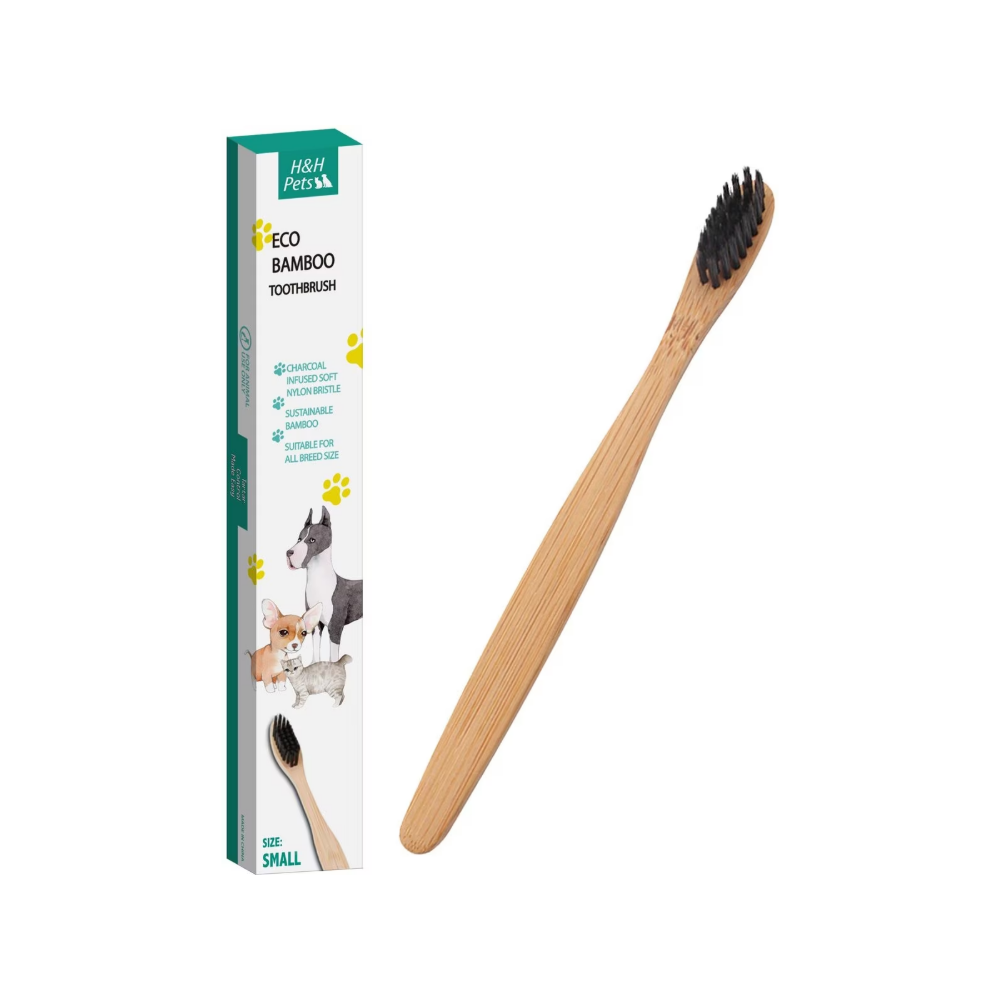
The best affordable toothbrush for dogs
This budget-friendly toothbrush is an excellent option for most dog breeds since it's available in two different sizes. It features a small head and soft bristles, designed to feel comfortable in your dog's mouth. The brush is infused with charcoal, known for its natural whitening properties and odor control, and the bristles are BPA-free, which is always good to know.
We like how the handle is made from biodegradable bamboo, making it a more eco-friendly choice compared to standard plastic models. You can purchase it as a single, three-pack, or eight-pack, giving you the flexibility to stock up so you're ready to replace it when you need to.
Reasons to buy: Soft and BPA-free bristles, bio-degradable handle, affordable.
Reasons to avoid: Basic design.
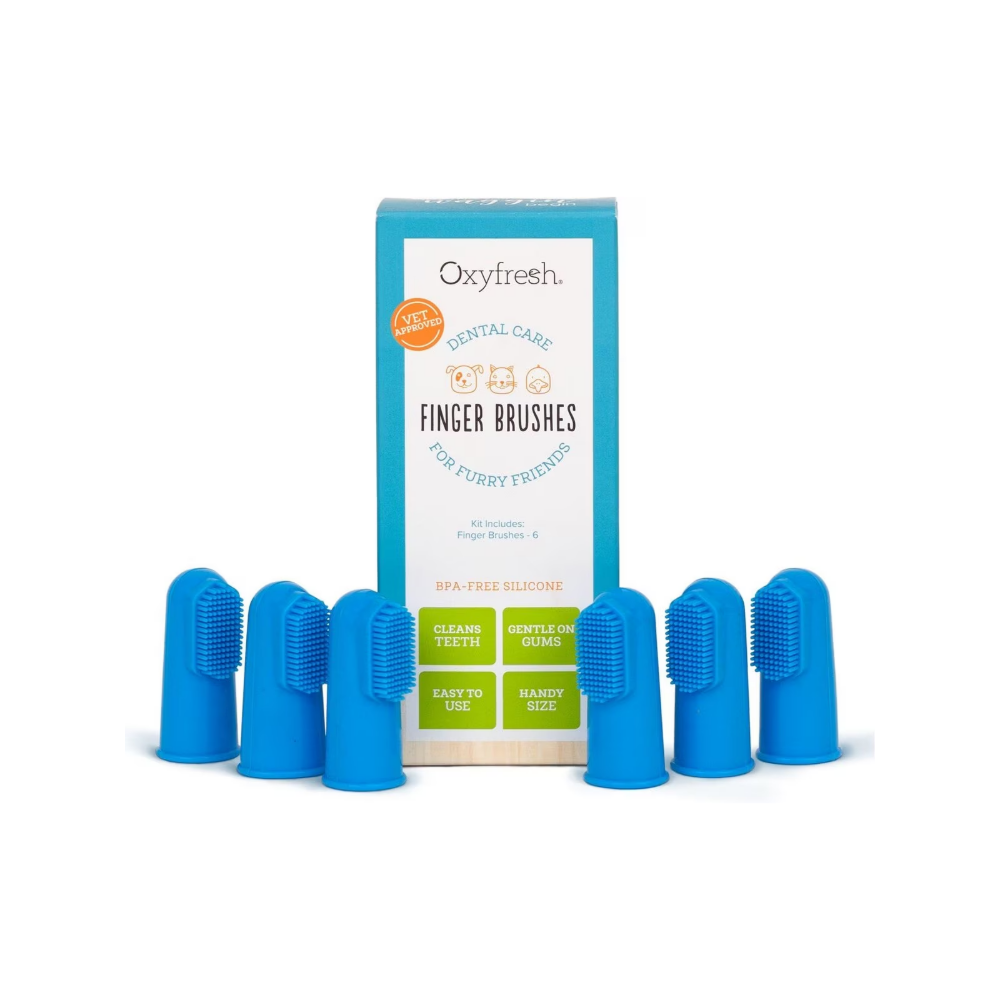
The best finger toothbrush for dogs
If your dog hates having their teeth cleaned, a silicone finger brush could be a total game-changer. While vets prefer traditional bristles for a deeper clean, these brushes can still benefit your dog's teeth while making the experience more enjoyable for them.
The Oxyfresh finger brushes are free from phthalates and BPA, so you can feel confident about using them in your dog's mouth. Simply put it on the end of your finger and run it along your dog's teeth—the anti-slip design ensures it stays securely in place. Plus, the price is super affordable, considering you get six in a pack.
Reasons to buy: BPA and phthalate-free, easy to use, affordable.
Reasons to avoid: Doesn't clean as well as a traditional brush.
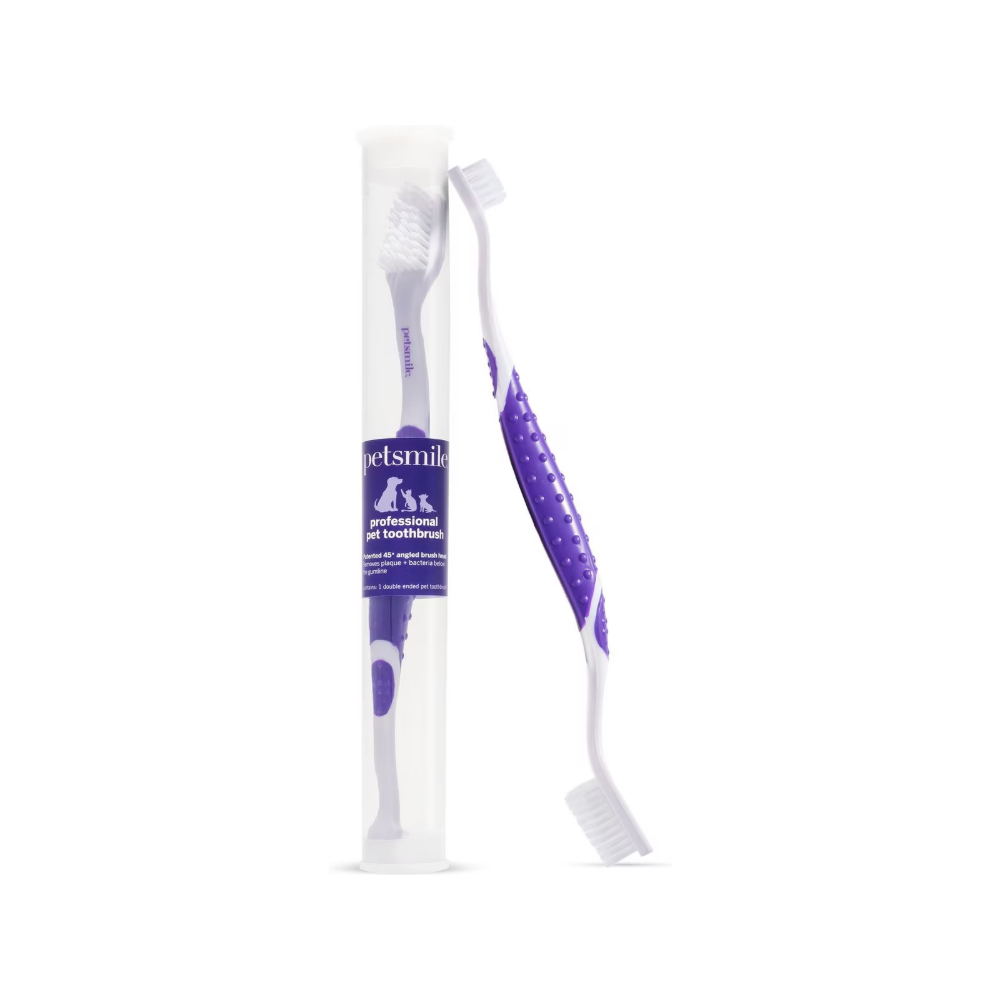
The best dual-ended toothbrush for dogs
This toothbrush is great for dogs of all sizes, thanks to its dual-ended design with two different brush shapes. The brushes are angled at 45 degrees, providing better control and making it easier to reach teeth in hard-to-access areas.
The bristles are super soft and are made from BPA-free nylon, making your dog's brushing experience safe and comfortable. The handle features a grip, helping you to hold onto it better without it slipping out of your hand.
Our tester is currently trying this out on her dog, Bailey.
Reasons to buy: Angled bristles, dual-ended, BPA-free, gripped handle.
Reasons to avoid: More expensive than other similar toothbrushes.
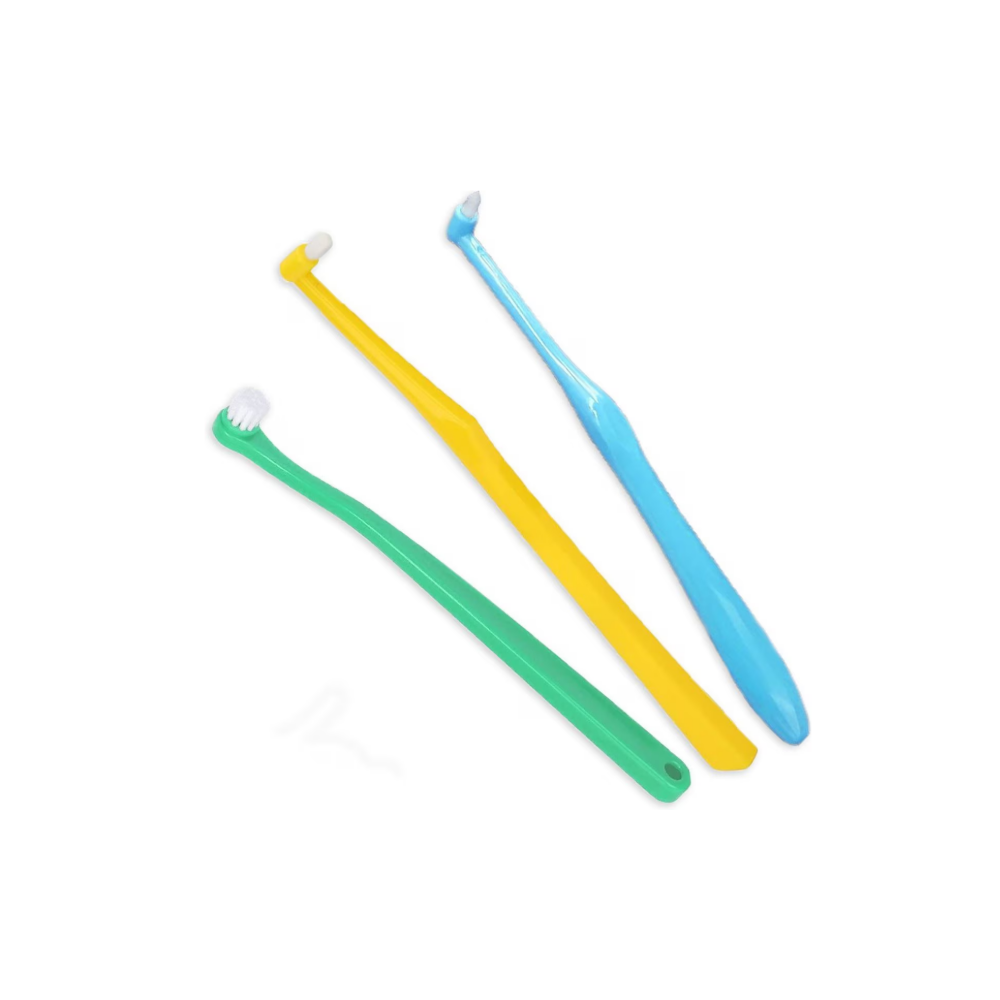
The best toothbrush for small dogs
If you have a small dog, I highly recommend this toothbrush kit which is designed specifically for little mouths. I've noticed that a lot of brushes don't cater to small or toy breeds, but this one is ideal, featuring three different brushes, each with tiny heads.
For under $10, you'll get a 1/4-inch pointed brush (perfect for getting into small gaps), a 1/4-inch flat brush and a 3/8-inch regular brush, which we think is great value for money. The bristles are made from soft nylon and reviewers have said it's very gentle in their dogs' mouths.
Reasons to buy: Three shapes and sizes to choose from, affordable.
Reasons to avoid: Doesn't specify if it's BPA-free, basic design.
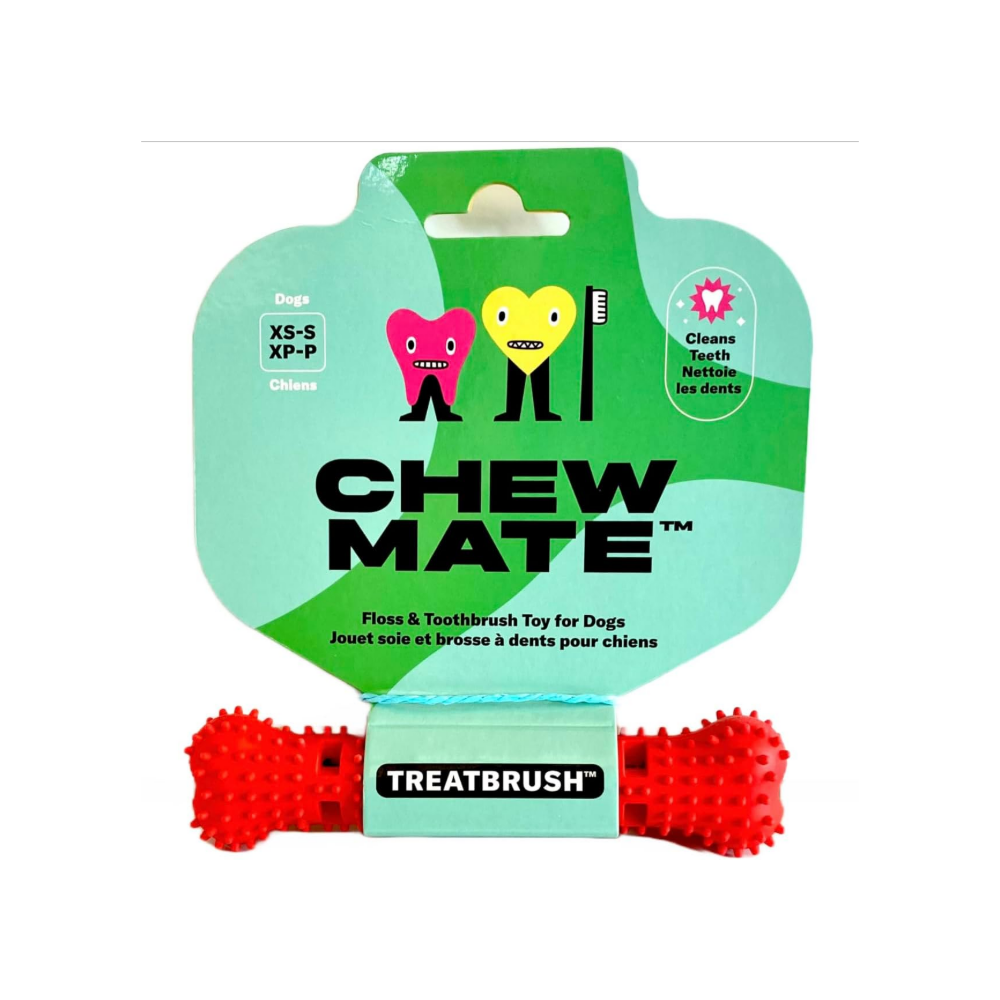
The best treat dispensing toothbrush for dogs
This treat-dispensing toothbrush will make your dog's oral routine a bit more fun. To retrieve the treats, they'll have to bite against the textured rubber, which can help to reduce bacterial levels in the mouth. There are two different sizes to choose from, and it's made from natural rubber that's BPA-free.
However, our vet notes that treat toothbrushes should be used alongside a traditional toothbrush - not as a replacement.
Our tester, Chloe, says: ""My dogs were so excited to play with this toy and enjoyed sniffing and biting into it. Since the hole is very small, you'll need tiny treats to prevent them from getting stuck (which happened to me). I'll definitely continue to brush my dogs' teeth in addition to using this, as they tend to bite the sides instead of the textured middle section. It makes a fun puzzle toy, though."
Reasons to buy: Fun to use, BPA-free.
Reasons to avoid: Shouldn't be used as a primary toothbrush.
Photos from testing
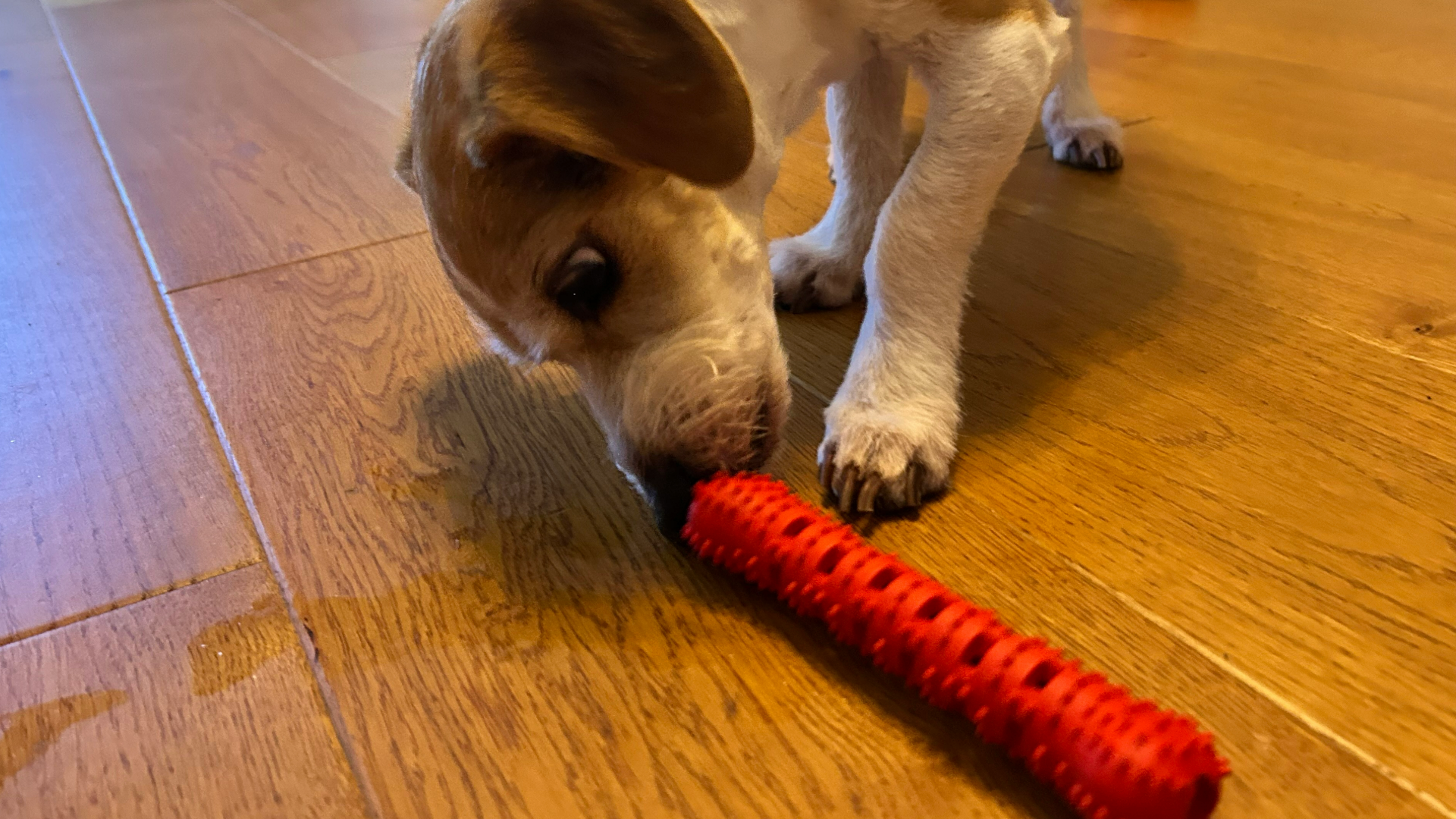
How we tested the best toothbrushes for dogs
Here at PetsRadar, we take your dog's health seriously, which is why we spent hours researching the best toothbrushes for dogs. We consulted our team of in-house vets to find out the best types of brushes and rule out any gimmicky options that don't have any real benefits.
We shortlisted a range of brushes with various price points, styles, and sizes, then put them to the test on our own pets. We're currently in the process of trying them out and have asked our testers for feedback on these questions:
Durability: Does the brush look and feel the same after it's been used? Does it feel high-quality and long-lasting?
Fit for purpose: Are you able to use it? Can you reach all of your dog's teeth?
User experience: How does the brush feel in your hand? Does it have any features that make the experience easier, like a gripped handle?
Value for money: Do you think this product is worth the money based on the quality and quantity? Would you recommend it to other pup parents?
Here's more information on how we test.
How to choose the best toothbrush for dogs
Dogs come in all shapes and sizes and, as you might expect, so do their mouths and teeth. If you have a toy or small breed dog, such as a shih tzu, you don’t want a large brush that is too big for their mouth, this will make the brush ineffective and pointless. Look for a brush that is specifically designed for small mouths.
For medium and larger breeds, you need a larger brush. Typically a double-ended toothbrush is a good choice for most dogs, but check out the length of the toothbrush shaft. Measure your dog's jaw from the front to their back teeth, though you can estimate this, and it will give you a rough idea of the size of toothbrush you will need. If you get one that is too short, you’ll need to put more of your hand in their mouth, which your pooch probably won’t appreciate.
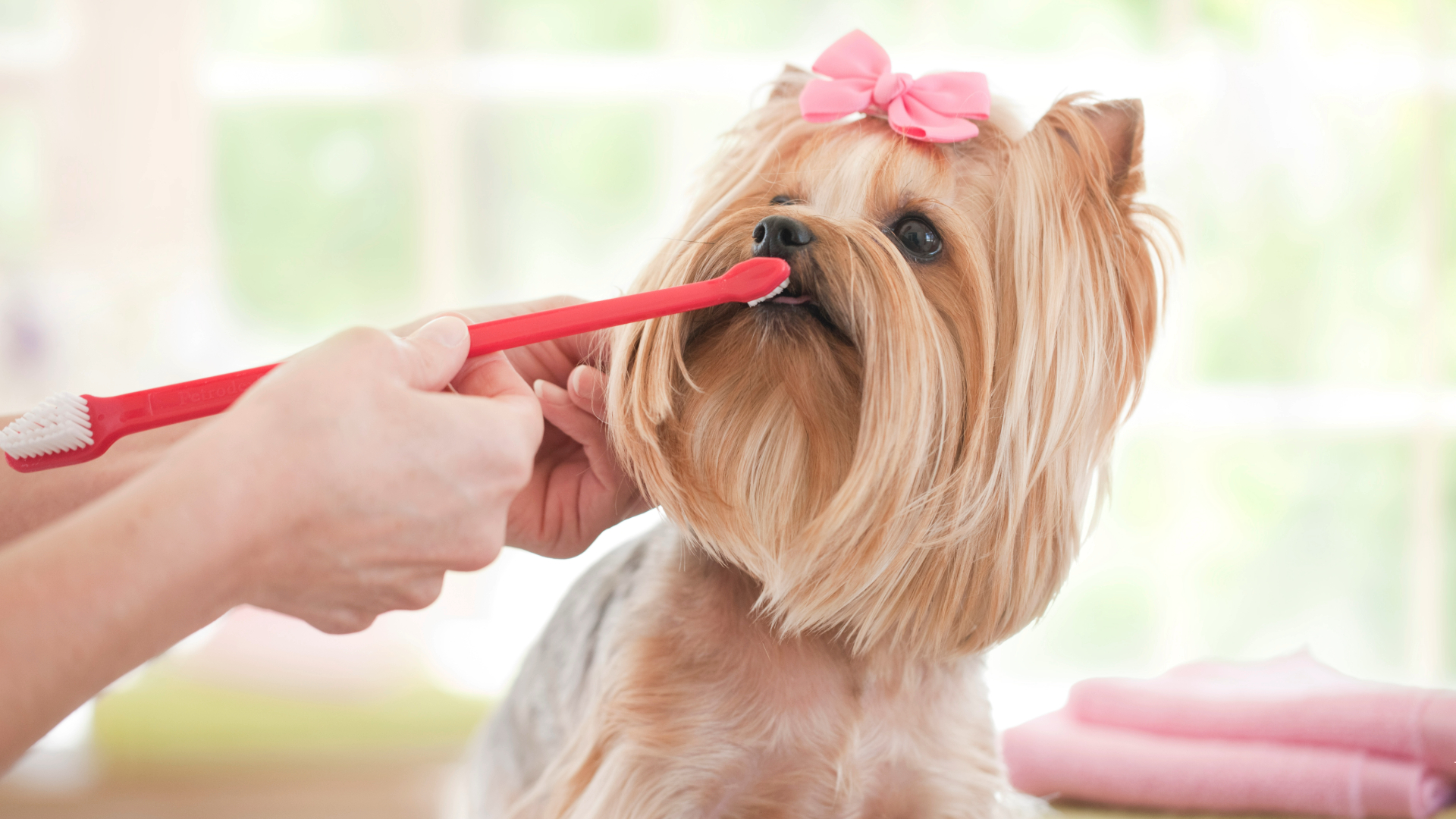
Which toothbrush is best for dogs?
If you're wondering which toothbrush is best for your dog, Dr. MacMillan is here to help! She recommends looking out for the following:
- Soft bristles
- A head that fits comfortably in the side of your dog's mouth
- Sturdiness
- A handle that is long enough to reach your dog's back teeth and is comfortable to hold
- An angular head can be useful
She says: "Traditional brushes with bristles, like we use, tend to be the most effective but some dogs are more compliant with finger brushes. Finger brushes can feel a bit less invasive and more comfortable than a traditional brush, but their lack of bristles means they may not clean as thoroughly.
"Electric toothbrushes are great and give a thorough clean. However, it can take longer for your pet to accept one, due to the noise and vibrations they make."
Can I use a human toothbrush on my dog?
Yes, you can use a human toothbrush on your dog — as long as it has soft bristles. However, when it comes to toothpaste, it's important that you stick to a pet-safe brand as human options are harmful to them.
Dr. MacMillan says: "Bristles that are too firm may be uncomfortable for your pet, creating trauma to their gums and putting them off the bushing process. Small children’s brushes with soft bristles can work quite well for smaller breeds of dogs. However, many owners find the shape of a dog toothbrush fits more comfortably in their pet’s mouth, compared to a human one."

When should I start brushing my dog's teeth?
Dr. MacMillan says it’s never too late to start brushing your dog’s teeth, though the earlier you start, the better. A good dental routine helps keep their teeth healthy and prevents issues like gum disease in dogs.
She advises: "When introducing your dog to a toothbrush make sure you do it gradually. In my experience, too many owners rush the training process and end up wrestling with their pets, which is not an enjoyable experience for anyone.
"Start by letting your dog sniff the brush, praising them gently, and giving them a treat. Then try some paste on the brush. Praise and reward them when they lick the paste off. Next try gently touching the brush on your dog’s lips, and practice lifting their lip to expose their teeth. Once they are happy with this, try a small amount of brushing, remembering to praise and reward your pet.
"Over time you will be able to increase the length of your teeth brushing sessions. Remember not to rush, each step may need to be practiced many times before you can move on to the next one. If at any point your pet seems stressed, then stop. Take a step back and progress again more slowly.
"If your dog is already showing signs of dental disease, like bleeding, inflamed gums, loose teeth, or heavy tartar build-up then you will need to consult with a vet before introducing toothbrushing. Brushing diseased teeth can cause your dog pain. It is much better to get their teeth properly treated by a veterinary professional before you start home brushing."
How often should I replace my dog's toothbrush?
You should expect to replace a dog's toothbrush every three months, but it depends on how often you brush your pooch’s teeth. A better indicator is when the bristles start to get frayed and flat, this is the time to invest in a new doggy toothbrush.
It makes sense that you buy more than one toothbrush at a time, but we would only recommend buying bigger packs after you have tried the brush before. If you buy in bulk and they’re no good for your dog, you have wasted your money.
You might also want to read our expert guides that answer, 'Can you use regular toothpaste on dogs?' and How to remove tartar build-up in dogs.
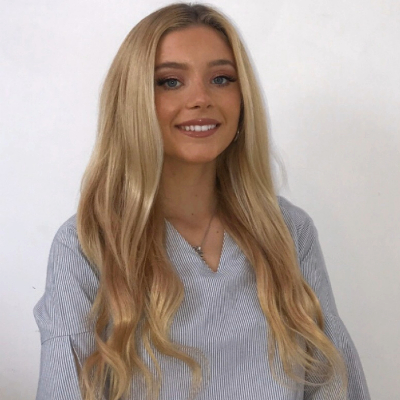
Megan is Staff Writer at PetsRadar, where she covers buying guides, deals, features, and news. As a former dog owner, she knows how important your pet's oral health is, which is why she is dedicated to finding the best toothbrushes for dogs. She spent hours refining this list and consulting experts to bring you the top options on the market.

Rebecca is a veterinary surgeon who graduated in 2009 from the Royal Veterinary College in London. She has a wealth of experience in first opinion small animal practice, having done a mixture of day-to-day routine work, on-call emergency duties and managerial roles over the years. She enjoys medicine in particular and she is proud to have recently achieved a BSAVA postgraduate certificate in small animal medicine (with commendation). She writes on various feline and canine topics, including behavior, nutrition, and health. Outside of work and writing she enjoys walking her own dog, spending time with her young family and baking!
Get the best advice, tips and top tech for your beloved Pets

Megan is a Staff Writer at PetsRadar, covering features, reviews, deals, and buying guides. She has a wealth of experience caring for animals, having grown up with dogs, cats, horses, guinea pigs, and more throughout her life. She studied BA Journalism at the University of Westminster, where she specialized in lifestyle journalism and was editor of Smoke Radio’s lifestyle website. Megan works alongside qualified vets and accredited trainers to ensure you get the best advice possible. She is passionate about finding accurate and helpful answers to your pet-related questions.
